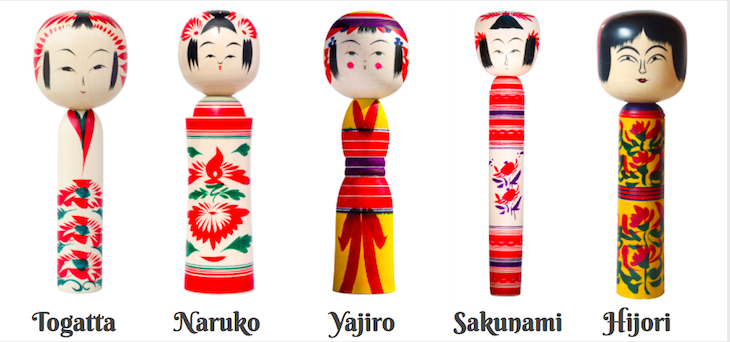If you are looking for a unique souvenir to bring family and friends from your trip to Japan, Kokeshi dolls are a great option. You have probably come across these iconic folk toys before.
But have you taken the time to examine them in detail? Did you notice the fine facial features and mysterious expressions? They exude a quiet beauty in their simplicity.
Origins of Kokeshi Dolls
Kokeshi dolls have a rich history. Legend has it that they trace their origins to Prince Koretaka (844-897), the eldest son of Emperor Montoku (827 – 858), who is credited for their invention. They are especially popular in the Tohoku region where a long line of artisans have passed the tradition from generation to generation.
In the past, Japanese people who embarked on pilgrimages often visit hot springs (onsen). They are especially popular during the winter months. This was the earliest form of local tourism. The villagers in the area would chop wood in the forest and make the wooden toys which were later on given to visitors as souvenirs. As they developed their skills in making Kokeshi dolls, the designs became more creative and elaborate.
Types of Kokeshi Dolls
Kokeshi dolls are classified depending on the region they come from. In Miyagi prefecture, the common types are Naruko, Togatta, Yajiro, Sakunami, and Hijiori.
Naruko Kokeshi originated from the Naruko hot springs. One unique feature of these dolls is that it produces a squeaky sound when the head is turned. They have gentle features and wider shoulders and skirts. They often exhibit a chrysanthemum motif and a red headdress.
Togatta Kokeshi was created in the Togatta hot spring. These dolls have a slim, straight, cylindrical body and a big head. The eyes are almond shaped and the nose looks like a two-pronged fork. The body is often painted with chrysanthemum, plum blossom or cherry blossom motifs. Their round faces are surrounded by red petals from the forehead to the cheeks.
Yajiro Kokeshi came from the Yajiro area which is located in Shiroishi Village. The doll’s head is painted with colorful rings that look like a beanie. They have single-lid eyes and a neko-bana (cat’s nose). They also feature a slender waist reminiscent of old Coca-cola bottles. They are believed to feature fun colorful designs because they come from the warmer Tohoku regions.
Sakunami Kokeshi was developed in the Sakunami hot springs. They have a very thin body which makes it easier for small children to grasp. The design on the body is referred to as kanikiku (crab chrysanthemum), because the flowers look like crabs. Originally the face appeared to be serious, but recently they have become kinder.
Hijiori Kokeshi started in the Hijiori hot springs in Yamagata Prefecture. It is inspired by the Togatta and Naruko styles. They have striking colors evocative of oil paintings and distinct patterns. They are easily recognizable because of their blocky head full of thick hair, double lid eyes and a flared nose. These types of dolls are the rarest ones.
Kokeshi Woodcrafting Techniques

The wood used to make Kokeshi dolls are from Cornel, Mono maple, Cherry trees, and Pagoda. During the winter season, these trees are cut and dried. After the wood is cured, it is placed on a lathe and polished to achieve a fine finish. A lathe is a tool that rotates the workpiece on an axis to perform various operations such as cutting, sanding, knurling, drilling. The craftsmen often use a knife called Bankaki to create their desired shape. Afterwards, the Kokeshi’s face and body is drawn and sealed with wax. One striking feature of Kokeshi dolls is their understated and mysterious smile that is reminiscent of the Mona Lisa.
Yasuo Okazaki shows us how he makes dolls from solid blocks of wood then finishes them with traditional stripes, bangs, and red headdresses.
Make Your Own Kokeshi at the Tsugaru Doll Museum
At the Tsugaru Traditional Craft Center, there are 7 studios for traditional Tsugaru crafts and performing arts such as lacquered ware and Kuroishi Neputa. Visitors can look around and try hand-made crafts or enjoy the live performances of Tsugaru-jamisen which are regularly held. The Tsugaru Kokeshi Doll Museum annexed to the store demonstrates how Kokeshi doll is made, and visitors can experience Kokeshi doll making.

Join the Kokeshi Doll Workshop (reservation required)
Contact tel: 0172-54-8181
Addmission: ¥1,200 per person
Many people have grown fond of Kokeshi dolls that they have become serious collectors. Each doll is unique because they are carefully crafted and hand painted by talented artisans. If you are interested to get your own Kokeshi doll or want to buy them as gifts, please visit JapaneseCraftworks.com. It offers Kokeshi dolls with a modern twist. Shipping is available worldwide.


